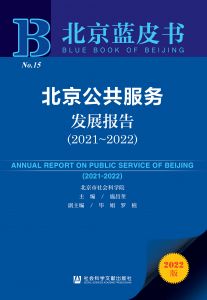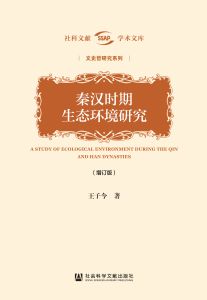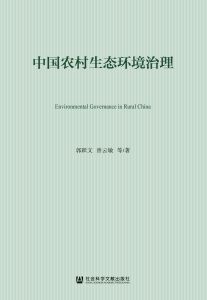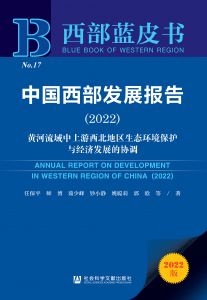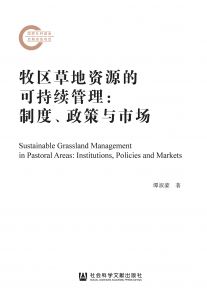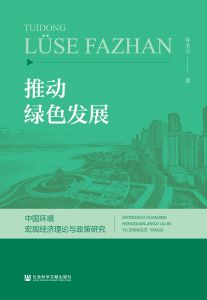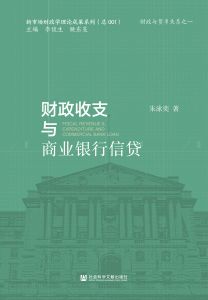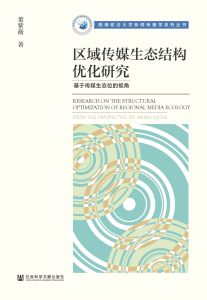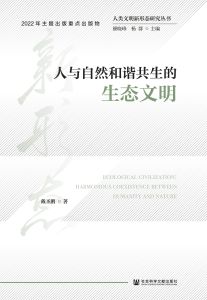首页 >
图书详情

图书简介
目录
参考文献
音频
视频
该书围绕政府和市场在生态补偿中的作用,探讨了三个政策主题,展示了五个案例研究成果。三个政策主题是:农业政策对生态补偿和土地利用的影响,全球化和国际环境公约对生态补偿的影响,以及流域森林生态效益补偿。
[展开]
-
Chapter 1 Payment for Environmental Services in China: The Role of Government and Market
-
1.1 Introduction
-
1.2 Review of current PWS like initiatives in China
-
1.3 Findings
-
1.4 Conclusions for the future
-
-
Chapter 2 Impacts of China’s Agricultural Policies on Payment for Environmental Services
-
2.1 Introduction
-
2.2 An Overview of China’s Agricultural Development
-
2.3 The Influence of Agricultural Policies on Payment for Environmental Services
-
2.4 Summary and the future of payments for environmental services
-
-
Chapter 3 A Review of Watershed Environmental Services from Forest in China
-
3.1 Introduction
-
3.2 Unprecedented Ecological Restoration in China
-
3.3 A Framework for Analyzing the Economics of PES for Watershed Forest Environmental Services
-
3.4 An Introduction to the Legal Frameworks and Transaction Systems of Chinese Payments for Watershed Forest Environmental Services
-
3.5 Conclusions
-
-
Chapter 4 The Impact of Globalization on Land Use and Management and Payments for Forest Environmental Services in China
-
4.1 Introduction
-
4.2 The globalization movement facing China
-
4.3 Impacts of globalization on land use in china
-
4.4 The impacts of WTO entry and international environmental agreements on payments for watershed services in China
-
4.5 Concluding comments
-
-
Chapter 5 Paying for Watershed Services in Jinhua Watershed in Zhejiang Province, China
-
5.1 Introduction
-
5.2 Overview of payments for watershed service
-
5.3 Research Methodology
-
5.4 Characteristics of the Study Region
-
5.5 Payment mechanisms in the Jinhua River
-
5.6 Analyses
-
5.7 Conclusions, lessons and suggestions
-
Appendix
-
-
Chapter 6 Is a Market-based Mechanism for Paying for Watershed Services in China Possible? A Feasibility Study for the Supa Watershed
-
6.1 Introduction
-
6.2 Research Methodology
-
6.3 Land and forest conservation policies in China
-
6.4 The Supa Watershed
-
6.5 Land Use Analysis
-
6.6 The Development of a Market-based Mechanism for Paying for Environmental Services in the Supa Watershed
-
6.7 Conclusions and Recommendations
-
Acknowledgements
-
Appendix
-
-
Chapter 7 Moving Toward A Market-Oriented Approach: Case Study of Forest Ecological Compensation Program in Miluo Watershed, Hunan, China
-
7.1 Introduction of FECP
-
7.2 Forest Ecological Compensation Program (FECP)
-
7.3 Research Findings
-
7.4 Lessons Learned from FECP in hunan province
-
-
Chapter 8 Development Contract with Terms of Watershed Conservation: A Win-win Opportunity for Development and Environment in the Meijiang Watershed, Ningdu County, Jiangxi Province, China
-
8.1 Introduction
-
8.2 Methodology
-
8.3 Conservation with development contract
-
8.4 Stakeholder analysis
-
8.5 Impact assessment
-
8.6 Implication for replication
-
Appendices
-
-
Chapter 9 Scale Matters: Paying for Watershed Services in the Xiaozhaizi Watershed
-
9.1 Introduction
-
9.2 Payments for Watershed Services in China and Yunnan Province
-
9.3 The Xiaozhaizi Watershed
-
9.4 Land Use Change in Baicai, Jinji, and Luozhai
-
9.5 Payments for Watershed Services in the Xiaozhaizi Watershed
-
9.6 Conclusions
-
Appendices: Legal provisions covering the environment and environmental protection in China
-
The Environmental Protection Law of the People’s Republic of China
-
The Law of the People’s Republic of China on Water and Soil Conservation
-
The Forest Law of the People’s Republic of China
-
Agriculture Law of the People’s Republic of China
-
[1][1]1.CCPCC (Chinese Communist Party Central Committee), 2003. Decisions on Some Issues on Socialist Market Economy. http: //www.china.org.cn/chinese/zhuanti/jjtzgg/450640.htm (access 2006-8-20).
[2][2]2.China Statistical Bulletin 2003, http: //www.stats.gov.cn/tjgb/, accessed 2006-9-10.
[3][3]3.Ecosystem Marketplace, 2006. Ecosystem Market Matrix: Ecosystem Service Payments-Today and in the Future. Washington, D.C.: The Katoomba Group’s Ecosystem Marketplace.
[4][4]4.FONAFIFO, 2005. The Environmental Services Payment Program: A Success Story of Sustainable Development Implementation In Costa Rica. FONAFIFO: Over a Decade of Action. San Jose: FONAFIFO (National Forestry Financing Fund).
[5][5]5.Heimlich R. E., 2002. The U.S. Experience With Land Retirement for Natural Resource Conservation . Presented to Forest Trends-China Workshop on “Forests and Ecosystem Services in China”, April 2002. Beijing, China.
[6][6]6.IIED, 2004. Developing Markets for Watershed Protection Services and Improved Livelihoods Implementation Phase Planning Workshop Report. 28~30 January 2004, London, IIED.
[7][7]7.IIED, 2005. Fair deals for watershed services: learning from new attempts to develop payments for watershed services that benefit livelihoods. IIED draft discussion paper, December 2005.
[8][8]8.Katoomba Group, 2006. Katoomba Group website (http: //www.katoombagroup.org) accessed 2006-9-4.
[9][9]9.Landell-Mills, Natasha and Ina Poras, 2002. Silver Bullet or Fools’ Gold? A global review of markets for forest environmental services and their impacts on the poor. London: IIED.
[10][10]10.Liu, Jianguo and Jared Diamond, 2005. China’s environment in a globalizing world. Nature, 435 (30 June): 1179-1186.
[11][11]11.Ministry of Land and Resources, 2005. In the past 8 years 100 million mu of arable land is lost. http: //www.gov.cn/ztzl/2005-10/27/content_85348.htm (accessible 2006-8-13).
[12][12]12.OECD, 2005. Economic Survey of China 2005. www.oecd.org/document/21/0,2340,en_2649_34571_35331797_1_1_1_1,00.html (accessible 2006-8-13).
[13][13]13.Quanzhou City Government, 2005. Directive on Financial Management for Watershed Conservation of the Upper Reaches of the Jinjiang, Luoyangjiang Rivers. Quanzhou Government official document No. (2005) 127.
[14][14]14.Quanzhou Municipal Government, 2005. Regulation on the use of the compensation fund for protection of water resources in the Jinjiang and Luoyangjiang watershed. Quanzhou Municipal Government document No. (2005) 127.
[15][15]15.Ravallion and Chen, 2001. Measuring Pro-Poor Growth, World Bank Policy Research Working Paper 2666. August, 2001.
[16][16]16.Scherr, S., M. Bennett, M. Loughney, and K. Canby. 2006. Developing Future Ecosystem Service Payments in China: Lessons Learned from International Experience. A Report Prepared for the China Council for International Cooperation on Environment and Development (CCICED) Taskforce on Eco-compensation. Forest Trends.
[17][17]17.SEPA (State Environmental Protection Administration), 2006. China Environmental Status Report 2005. (http: //www.zhb.gov.cn/eic/649368311779295232/index.shtml) (accessible 2006-8-13).
[18][18]18.SLCP Office, 2006. CNY103 billion yuan has been invested in the SLCP in the past 7 years. see official website of SLCP Office (in Chinese) http: //www.tghl.gov baodao/baodao_show.aspx?id=1485 (access 2006-8-20).
[19][19]19.State Council and CCPCC, 2004. Policy Proposals on Increasing Farmer’s Income. (No. 1 Document 2004). http: //www.china.org.cn/chinese/PI-c/493311.htm (access 2006-8-20).
[20][20]20.State Council, 2006. 11th Five Year Plan for National Economic and Social Development of China. http: //www.gov.cn/ztzl/2006-03/16/content_228841.htm (access 2006-8-20).
[21][21]21.State Council, 2006a. White Paper on China’s Environmental Protection (1996~2005). http: //www.chinadaily.com.cn/china/2006-06/05/content_608517.htm(access 2006-8-20).
[22][22]22.Sun Changjin and Chen Liqiao, 2006. A Review of Watershed Environmental Services in China. See Chapter 3.
[23][23]23.UNDP, 2004. Human Development Report 2004. Oxford University Press: Table 14.
[24][24]24.Wang Xuechun, 2003. China’s potential in Carbon trade. See Wei Diansheng, Afforestation and Climate Change. Beijing: China Forestry Press.
[25][25]25.World Bank, 2006. World Economic Indicator (for 2005) 2006~2007.
[26][26]26.Wunder, Sven, 2005. Payments for Environmental Services: some nuts and bolts. CIFOR occasional paper No. 42.
[27][27]27.Xu, Jintao, Tao Ran, and Xu Zhigang, 2004. Sloping Land Conversion Program: Cost-effectiveness, Structural Adjustment, and Economic Sustainability—an Empirical Study based on Household Survey in 3 Western Provinces. China Research Center, Chinese University of Hong Kong. http: //www.usc.cuhk.edu.hk/wkgb.asp (access 2006-8-20).
[28][28]28.Zhang Lubiao, Zheng Haixia, and Chen Yanjun, 2006. Paying for watersheds services in Jinhua watershed in Zhejiang province, China. See Chapter 5.
[29][29]29.Zuo Ting, Jin Leshan, Gou Tianlai, Zhang Binqian, and Li Xiaoyun, 2006. Moving Toward A Market-Oriented Approach: Case Study of Forest Ecological Compensation Program in Miluo Watershed, Hunan, China. See Chapter 7.
[30][30]1.Chen Gang. 2003. Why Do We Turn Grassland to Farmland. Outlook News Weekly 17.
[31][31]2.Chen Yinjun and Zhang Yanqing. 2002. Solving the Issues about Livelihood and Increased Income of Farmers and Herdsmen is Key to Curb Sand Storm. Issues of Agricultural Economy 8.
[32][32]3.Ding Caixue. 2002. A Probe into the Ecological and Environmental Compensation Mechanism. Environmental Monitoring 5.
[33][33]4.Ding Xuegang. 2003. A Probe into the Issues of Ecological and Environmental Compensations. Qinghai Environment 4.
[34][34]6.Du Qinglin. 2004. Making Intensified Efforts to Build A Long-term Effective Mechanism for Grain Production. Qiushi Journal 21.
[35][35]7.Du Qinglin. 2004. Taking Precautions to Ensure Grain security. Issues of Agricultural Economy 6.
[36][36]8.Du Wanping. 2001. Proposals about Improvement of the Regional Ecological Compensation Mechanism for Western Regions. Chinese Population. Resources and Environment 3.
[37][37]9.Fan Xiaojian. 2003. A Review and Consideration of the Strategic Adjustment of Agricultural and Rural Economic Structure. China’s Rural Economy 6.
[38][38]10.Fang Yan. 2003. The Policy, Technology and Management of Sustainable Agricultural development. China Agriculture Publishing House . 1st Edition, Nov.
[39][39]11.Gong Yazhen. 2002. The Implications to China of the Policies for Compensations for Ecological Benefit Implemented By Countries in the World. Management of Forestry Science and Technology 3.
[40][40]12.Guo Xiaoming. 2004. A Survey and Analysis of the Project of Returning Reclaimed Farmlands to Forestry. China Territory Today 10.
[41][41]13.Han Jun. 2004. Some Proposals for the Current Policy Issues about Agriculture and Rural Economy. Rural Economy 1.
[42][42]14.Hu Biliang. 2003. How to Evaluate the Issues about China’s Agriculture, Rural Areas and Farmers. China’s Rural Economy 8.
[43][43]15.Hu Dandan. 2004. China’s Export of Green Food Grew by 50% in 2004. (available online at: http: //www.xinhuanet.com, Sep. 29).
[44][44]16.Hu Liangyu. 2003. Hui Liangyu: Increasing Farmers’ Income, Ensuring Grain Supply and Realizing Overall Economic and Social Development in Rural Areas. (available online at: www.Xinhuanet.com, Dec. 24).
[45][45]17.Hu Xiaoping. 2001. Macro Policies are the Decisive Factor that Influences Grain Production in China. China’s Rural Economy 11.
[46][46]18.Huang He and Li Yongning. 2004. Some Considerations about the Sustainability of the Projects of Returning Reclaimed Farmlands to Forestry and Rangeland Retirement Program (RRP) in Western Regions. Journal of Socialist Theory Guide 2.
[47][47]19.Industry Policy and Regulation Department of the Ministry of Agriculture. 2004. Survey and Research of Rural Policies and Legislation (2003). China Agriculture Publishing House . 1st Edition, April.
[48][48]20.Jiang Hai. 2003. Micro Investment Stimulus to the Returning of Reclaimed Farmlands to Forestry in China and the Sustainability of Policies. China’s Rural Economy 8.
[49][49]21.Jin Leshan et al . Pay for the Valley’s Eco-environmental services: The Role of Market.
[50][50]22.La Dan and Li Yanhong. 2003. Some Considerations about Rangeland Retirement Program (RRP). Qinghai Prataculture 3.
[51][51]23.Li Chenggui. 1999. China’s Agricultural Policy-Theoretical Framework and Application Analysis. Social Sciences Documentary Publishing House 1.
[52][52]24.Li Keguo. 2000. The Theory and Practice of the Policy for Ecological and Environmental Compensations. Environmental Science Trends 2.
[53][53]25.Li Xiaoyun. 2004. Report on China’s Rural Conditions 2003~2004. Social Sciences Documentary Publishing House . 1st Edition, Dec.
[54][54]26.Liu Can and Lu Jinzhi. 2003. A Research on the Issues of Compensations for Forestry Ecological Benefit in China. Theory 1.
[55][55]27.Liu Jing and Luo Zuoxian. 2004. Industrialization and Ecology: An Option for the Route to the Gradual Progress of the Agricultural Industrial Structure in Western Regions. Rural Economy 7.
[56][56]28.Ma Youxiang. 2004. Cultivating a Scientific Concept of Development to Build a Long-term Effective Mechanism for Grain security in China. China’s Rural Economy 10.
[57][57]29.Mao Yugang. 2001. A Probe into the Evolution of China’s Agriculture. Social Sciences Documentary Publishing House . 1st Edition, July.
[58][58]30.National Bureau of Statistics of China, 2005. China Statistical Yearbook 2005. China Statistics Press, Beijing Info Press, Beijing (available online at: http: //www.stats.gov.cn/tjsj/ndsj/2005/indexeh.htm).
[59][59]31.Ni Feng. 2000. A Comment on Some Basic Issues about the Strategic Adjustment of the Current Agricultural Structure. Issues of Agricultural Economy 11.
[60][60]32.Office of the Soft Science Committee under the Ministry of Agriculture. 2001. Adjustment of Agricultural Structure and Regional Policies. China Agriculture Publishing House Nov. 1.
[61][61]33.Research Institute of Rural Economy under the Ministry of Agriculture, “Report on the Development of China’s agriculture” 1995~2003.
[62][62]34.SEPA, 1997. Bulletin on the Environmental Pollution from the Township Enterprises. China Township Enterprise Newspaper , 1997-12-23.
[63][63]35.Shi Shaolong. 2004. A Summary of the Researches on Grain security in 2003. Issues of Agricultural Economy 9.
[64][64]36.Song Hongyuan et al . 2000. The Evolution of China’s Policies about Agriculture and Rural Economy Since 1978. China Economics Press . 1st Edition, Oct.
[65][65]37.Song Hongyuan et al . 2002. The Policies about Agriculture and Rural Economy During the Period of 9th Five-Year Plan. China Agriculture Publishing House . 1st Edition, July.
[66][66]38.Tang Huajun, Qian Xiaoping et al . 2003. Supply and Demand of Food, Adjustment of Agricultural Structure and Sustainable Development. China Meteorological Press . 1st Edition, Sep..
[67][67]39.Tang Huajun. 2002. A Research on Utilization of Agricultural Resources and Regional Sustainable Development. China Population Press . 1st Edition, March.
[68][68]40.Tao Ran et al . 2004, Returning Reclaimed Farmlands to Forestry: Cost-effectiveness, Effect of Structural Adjustment and Economic Sustainability-A Demonstrative Analysis based on the Survey of Farmers in Three Provinces in the Western Regions (Available online at: http: //www.studa.net/Place/060102/14492140-2.html).
[69][69]41.The bureau of statistical of China. 1980~1999. China Statistical Yearbook. The statistical express. Beijing.
[70][70]42.The Central Committee of China Zi Gong Party. 2003. Building the Ecological and Environmental Compensation Mechanism, Practicing Circulating Economic Development Model. China Development 3.
[71][71]43.The General Team for Rural Investigation. The Total Grain Yield of the Country Reached 861.3 Billion Jin in 2003 (available online at: http: //www.sannong.gov.cn).
[72][72]44.The Ministry of Land and Resource. 2003. The Official Report of China Land and Resources. Beijing.
[73][73]45.The Task Team of the Soft Science Committee under the Ministry of Agriculture. 2001. The Features of China’s Agriculture Entering into the New Stage and Policy Study. Issues of Agricultural Economy 1.
[74][74]46.Wan Baorui. 2004. Strategic Countermeasures for Increasing Farmer’s Income and Ensuring Grain security. Issues of Agricultural Economy 4.
[75][75]47.Wang Qinmin. 2004. Setting Up the Compensation Mechanism to Protect Ecological Environment. Qiushi Journal 13.
[76][76]48.Wang Xiangyang et al . 2003. The policy Supports for Rangeland Retirement Program (RRP) in the Pasturing Areas in the Western Regions of China. the Issues of Agricultural Economy 7.
[77][77]49.Wang Xiaogang. 2003. The Interest Compensation Mechanism for Protection and Construction Ecological Environment in the Western Development. Tian Fu New Idea 2.
[78][78]50.Wei Wei and Yang Weijun. 2004. A Research on the Exteriority of Agriculture and Compensations. Journal of North Western University (Philosophy and Social Sciences Edition) 1.
[79][79]51.Wu Chuanjun. 2001. A Review of the Issues about China’s Agriculture and Sustainable Development of Rural Economy. China Environmental Science Press . 1st Edition, March.
[80][80]52.Xie Peixiu. 2000. China’s Grain security and Sustainable Development of Agriculture. China Soft Science 2.
[81][81]53.Xiong Ying and others. 2003. The Ecological Compensation Mechanism for Returning Reclaimed Farmlands to the Lake in the Dongting Lake Regions. Rural Eco-Environment 19.
[82][82]54.Yang Yongzhe. 2004. Environmental Protection and Sustainable Development of Agriculture. Qiushi Journal 5.
[83][83]55.Ye Xingqing. 2004. Some Thoughts about Promotion of the Coordinated Development Between Rural and Urban Areas. Issues of Agricultural Economy 1.
[84][84]56.Yin Chengjie. 2003. Thoughts about the Ups and Downs of Grain Production in China and Proposals. Issues of Agricultural Economy 10.
[85][85]57.Zengyao He, Zhaojie Ye, Fangzheng Wu. 1999. Synopsis of Environmental Science of Agriculture. Shanghai Science and Technology Press . Shanghai.
[86][86]58.Zhang Lubiao and Zheng Haixia. 2004. The Research Progress and Formation Mechanism of Valley’s Ecological Service Market. Natural Ecological Conservation 12.
[87][87]59.Zhang Xiaoli and He Ying. 2002. A Review of the Effects of the Policy about Returning Reclaimed Farmlands to Forestry and Rangeland Retirement Program (RRP) in Implementing the Strategy of Western Development. Forestry Science 1.
[88][88]60.Zhao Wenxin. 2004. Thinking about the Issues about the Current Economic Development in Rural Areas. Rural Economy 9.
[89][89]61.Zhejiang Gradually Sets up the Ecological Compensation Mechanism. 2002. Shenzhen Special Economic Zone Daily . July 4.
[90][90]62.Zhong Funing. 2003. Agricultural Policy. China Agriculture Publishing House . 1st Edition, June.
[91][91]63.Zhong Yu and others. 2002. A Research on the Ecological Compensation Mechanism for Returning Reclaimed Farmlands to Lakes-Case of the Boyang Lake Regions. Chinese Population.Resources and Environment 4.
[92][92]64.Zhu Guangyao. 2004. On the International Seminar on‘The Compensation Mechanism and Policies for Ecological Conservation and Construction, Zhu Guangyao Emphasizes It’s A Long-term, Arduous Task to Formulate and Improve the Policies for Ecological Compensations in China’. China Environmental News . October 29.
[93][93]1.Ao Rengqi, 2003, “The institutional evolution of grassland property rights and their innovations[J]”. Inner Mongolian Social Sciences , Vol24, No.4, Inner Mongolian Social Science Academy pp.116~120.
[94][94]2.Anonymous, “The impacts of Doha Negotiation agreements on Chinese agriculture”.WTO and Law Forum.Available online at: http: //www.wtolaw.gov.cn/display/displayInfo.asp?IID=200408231703202555(accessed March 07, 2005), originally from Asian Pacific Economic Times, 2004-8-03.
[95][95]3.Chen Liang and Zhang Yun (2004), “Issues and Solutions in Rural Land Use” in Rural Economy.Chengdu: Sichuan Agricultural Economics Association , 2004, No.1 pp.29~33Chen Xiwen.“Stablizing household contracting responsibility system”.Available online at: http: //www.china.com.cn/zhuanti2005/txt/2003-03/04/content_5286369.htm (accessed March 09, 2005).Original paper from China Economic Times.
[96][96]4.Du Kailong, Li Xingjiang (2003), “A historical review of rural land tenure systems in China”.Huzhou Normal College Bulletin .Vol.25, No.1, pp.70~74 Huzhou Normal College, Huzhou.
[97][97]5.Gao Jinghua (2004), “A research into the sustainable use of rural land resources after China’s WTO entry”.Economic Survey , 2004, No.1, pp.102~104 Henan Finance College, Zhengzhou.
[98][98]6.Han Jing (2002), “The evolution and reform strategies in rural land systems since the establishment of the People’s Republic of China’ CCPC Sichuan Party School Publication”, 2002 No.2, pp.58~61 CCPC Sichuan Party School, Chengdu.
[99][99]7.Ke Bingsheng, “An analysis and outlook of agricultural development in China three years after China’s WTO entry’Agricultural Economic Issues”, 2005, No.5. Agricultural Economics Research Institute, Chinese Academy of Agricultural Academy, Beijing.
[100][100]8.Li Qiuyi, “The theory and practice of wetland legal protection”.Available online at China Environmental Law Net: http: //www.riel.whu.edu.cn/show.asp?ID=1934 (accessed 21 March 2005).
[101][101]9.Liu Jianguo and Jared Diamond, (2005) “China’s environment in a globalizing world”.World Environment (2005, No.4, pp.45~56, Chinese Academy of Environmental Sciences Publishing House, Beijing) 1179~1186.
[102][102]10.Liu Fengqing (2003), “A study of scales in Chinese agricultural land management”. Finance and Economics Research , Vol.239, No.10, pp.60~65 Northeastern Finance University, Dalian.
[103][103]11.Qu Liping (2002), “A study into the use and management of rural land resources after the WTO entry”, Collections of Research Papers on Land Issues in the New Century: Hubei: Hubei Science and Technology Publishing House, Zhang Jianren ed .2002 pp.83~88.
[104][104]12.Ren Bo, “(2004) Chinese agricultural products trade is increasingly diversifying, and the Doha Round negotiations have an insignificant impact”.Available online at China News Net: http: //www.chinanews.com.cn/n/2004-04-12/26/424256.html(accessed 19 March 2005).Originally from Finance and Economics, 2004-4-12.
[105][105]13.Sun, Changjin and Chen, Liqiao, “A Study of Policies and Legislation Affecting Payments for Watershed Environmental Services in China”.Unpublished manuscript, 2005, Beijing.
[106][106]14.Tie Zheng (2003), Guanjunwei on combating desertification in China.Available online at People’s Net: (http: //www.people.com.cn/GB/huanbao/1074/1966744.html, accessed 08 March 2005).
[107][107]15.Tu Ruihe (2004), “Environmental treaties that China has ratified and the status of fulfilling its obligations”.Available online at China.People’s Net: (http: //www.people.com.cn/GB/huanbao/8220/41430/41433/3029062.html, accessed 21 April 2005).
[108][108]16.Wang Chunxue (2003), “An Analysis of Forest Carbon Credit Projects and their Development Potential in China”.In Afforestation and Climate Change , Wei Diansheng ed.Beijing, China Forestry Press, 2003.
[109][109]17.Wang Jing (2002), “The globalization of environmental issues and its legal coping strategies”.Law and Social Development .(Vol.47, No.5 pp.45~54) Jilin University, Changchun.
[110][110]18.Wang Weiguo (2003), “The status and reform of China land laws”.Available online at Chinese civil commercial laws net: http: //www.civillaw.com.cn/weizhang/default.asp?id=24300(accessed 06 May 2005).
[111][111]19.Wei Qian (2002), “The structure and evolution of Chinese rural land property rights systems”.Social Sciences , Shanghai Social Science Academy, 2002, No.7, pp.18~22.
[112][112]20.Xu Li (2004), “The defects in existing rural land property rights”.Rural Economy , Chengdu, Sichuan Agricultural Economics Association, 2004, No.11, pp.28~29.
[113][113]21.Xu Xiuying and Wu Weiguang (2004), “The historical evolution of collective forest land tenure in the Southern Collective Forest Region”.World Forestry Research , Beijing: State Forestry Administration Intelligence Center.Vol.17, No.3.
[114][114]22.Yao Runfeng, “Dong Jun (2005).40% of Chinese wetlands are being effectively protected”.Available online at Xinhua News Net: (http: //news.xinhuanet.com/newscenter/2005-02/02/content_2540055.htm(accessed 10 April 2005).
[115][115]23.Yin Yin Ping (2004), Chinese Forestry Will Be More Open in the Coming Five Years.Available online at: http: //lsly.gov.cn/0202/6194.htm(accessed 07 March 2005).Original paper from China Green Times.
[116][116]24.Zhou Lan (2004), “On the improvement of the biodiversity conservation law system in China”.Available online at: http: //www.riel.whu.edu.cn/show.asp?ID=2232 (accessed 09 April 2005).
[117][117]25.Zhou Yi, “Chinese Ecological Environment Safety”. Northwestern Forestry College Bulletin .Xianyang, Shaanxi Agricultural and Forestry Sciences and Technology University, Vol.18, No.1, pp.109~112.
[118][118]26.Zhu Qiuxia, On the quasi-state feature of existing rural land systems and the necessity to reform.Available online at: http: //www.unirule.org.cn/symposium/c274.htm (accessed 13 April 2005).
[119][119]27.CBD (2005) “Section II.Cartagena Protocol on Biosafety to the Convention on Biological Diversity”CBD Handbook (3rd Edition). (Available online at: http: //www.biodiv.org/doc/handbook/cbd-hb-02-en.pdf(accessed 20 July 2005)).
[120][120]28.CCICCD (1996) China National Action Plan to Combat Desertification .China National Committee for the Implementation of the UN Convention to Combat Desertification.Beijing, China. (Abstract available online at: http: //www.unccd.int/actionprogrammes/asia/national/2000/china-eng.pdf(accessed 09 July 2005).
[121][121]29.CCICCD (2002) China National Report to Implement the United Nation’s Convention to Combat Desertification (UNCCD) . Committee for the Implementation of the UN Convention to Combat Desertification.Beijing, China. (Abstract available online at: http: //www.unccd.int/cop/reports/asia/national/2002/china-eng.pdf, accessed 05 August 2005).
[122][122]30.NEPA (1994) China Biodiversity Conservation Action Plan .National Environmental Protection Agency.Beijing, China. (Available online at: http: //www.bpsp-neca.brim.ac.cn/books/actpln_cn/index.html, accessed 13 April 2005).
[123][123]31.Ramsar (2002) The Ramsar Strategic Plan 2003~2008 .Resolution VIII.25 of the 8th Meeting of the Conference of the Contracting Parties to the Convention on Wetlands (Ramsar, Iran, 1971).Valencia, Spain, 18~26 November 2002. (Available online at: http: //www.ramsar.org/res/key_res_viii_25_e.htm, accessed 11 August 2005).
[124][124]32.Pearson, T., S.Walker and S.Brown (2005) Source Book for Land Use, Land-Use Change and Forestry Projects .Bio-Carbon Fund and Winrock International, The World Bank, Washington D.C.. (Available online at: http: //carbonfinance.org/docs/LULUCF_Sourcebook_compressed.pdf, accessed 16 June 2005).
[125][125]33.RCIO (2005) National Planning Tool for the Implementation of the Ramsar Convention on Wetlands [China] .National Report submitted to the 9th Meeting of the Conference of the Contracting Parties to the Convention on Wetlands (Ramsar, Iran, 1971), Kampala, Uganda, 8~15 November 2005. Ramsar Convention Implementing Office, Beijing, China. (Available online at: http: //www.ramsar.org/cop9/cop9_nr_china.pdf, accessed 22 July 2005).
[126][126]34.WTO (2005) Understanding the WTO .Information and Media Relations Division, World Trade Organization, Geneva, Switzerland. (Available online at: http: //www.wto.org/english/thewto_e/whatis_e/tif_e/understanding_e.pdf, accessed 02 August 2005).
[127][127]1.Bayha K., C.Koski. Anatomy of a River: an Evaluation of Water Requirements for the Hells Canyon Reach of Snake River [M]. Pacific North West River Basins Commission, Vancouver, Washington, plus Appendix. 1974.203.
[128][128]2.Bowker J.M., D.B.English, J.A.Donovan. Toward a value for guided rafting on southern Rivers [J]. Journal of Agricultural and Applied Economics, 1996, 28(2): 423~432.
[129][129]3.Boyle K.J., M.P.Welsh, R.C.Bishop. The role of question order and respondent experiences in contingent valuation studied [J], Journal Of Environmental Economics And Management, 1993, 25: 80~90.
[130][130]4.Chen Honghui, Jia Shenghua. A Positive Analysis on the Tri-dimensional Classification of the Stakeholders in Corporation, Economic Study, 2004(4): 80~90.
[131][131]5.Chunxia Nu, Gaodi Xie, Shenqui Chen. The recreation function and its value evaluation of River ecology system, Resource Science, 2001, 23(5): 77~81.
[132][132]6.Daubert J., R.Young. Recreational demands for maintaining in stream flows: a contingent valuation approach [J]. American journal of agricultural economics, 1981, 63(4): 666~675.
[133][133]7.Feng Zhiming, Zheng Haixia, Yang Taiba, GIS Analysis of Crop Production Potentials in Gansu Province, Journal of Lanzhou University (Natural Science Edition), 2005(1): 12~18.
[134][134]8.Ian Powell, Andy White and Natasha Landell-Mills, Developing Markets for the Ecosystem Services of Forests, 2002, http: //www.forest-trends.org.
[135][135]9.Landell-Mills, N. Porras I T., Silver bullet or fools’ gold? A global review of markets for forest environmental services and their impacts on the poor, International Institute for Environment and Development(IIED), 2001.
[136][136]10.Li Xiaoyun, el. A General Study on Participatory Development, Theory, Methodology and Tool, the Press of Chinese Agricultural University, 2001: 135~139.
[137][137]11.Manrique Rojas, Bruce Aylward. What are we learning from experiences with markets for environmental services in Costa Rica? Environmental Economics Programme (EEP), IIED, http: //www.eldis.org/static/DOC12191.htm.
[138][138]12.National Territory and Resources Bureau of Pan’an county, Zhejiang province. The Land Development Clearing-up and Programming of Pan’an County, http: //www.tdzl.cn/jhtdzl/pa/zxgh.htm.
[139][139]13.Perrot-Maitre D. and P.Davis. Case Studies of Markets and Innovative Financial Mechanisms for Water Services from Forests, Forest Trends, 2001, http: //www.forest-trends.org.
[140][140]14.Tongqian Zhao, Zhiyun Ouyang, Xiaoke Wang. Ecosystem service function and the ecological and economic value evaluation of surface water in China, Journal of Natural Resource, 2003, 18(4): 443~452.
[141][141]15.Ward F.A.. Economics of water allocation to in stream uses in a fully appropriate River basin: evidence from a New Mexico Wild River [J]. Water Resources Research, 1987, 23(3): 381~392.
[142][142]16.Wu Liansheng. The Features of Stakeholders’ Participatory in Making Accounting Roles, Economic Study, 2004(4): 88~97.
[143][143]17.Xie Gaodi, Lu Chunxia, Leng Yunfa, Valuing the ecological assets in Qingzhang highlands, Journal of Natural Resource, 2004(4): 80~90.
[144][144]18.Young R.A., S.L.Gray. Economic value of water: concepts and empirical estimates. Final rep. To the Natl. Water Qual. Comm. [M]. Contract Nwc, 70~280, Colo. State univ. Fort Collins, March, 1972.
[145][145]19.Zheng Yisheng, Sun zhen. To Get Eco-services Paid by Establishing Ecological Region, the paper collection from the international forum of Compensation Mechanism and Policies of Ecological Protection and Construction, 2004, 27~31.
[146][146]20.Zhiqiang Zhang, Zhongming Xu, Guodong Chen. Condition value evaluation to ecosystem service resume in Heihe basin in Zhangye region, Journal of Ecology, 2002, 26(2): 885~863.
[147][147]21.Zhiqiang Zhang, Zhongming Xu, Jian Wang and so on. Value of ecosystem service in Heihe basin, glacier and frozen earth: 2001, 23(4): 360~366.
[148][148]1.Cai Mantang, Liu Dachang and J.W.Turnbull, 2003, Rehabilitation of Degraded Forests to improve the Livelihoods of Poor Farmers: A Synthesis of Four Case Studies in South China in Rehabilitation of Degraded Forests to Improve Livelihoods of Poor Farmers in South China. Liu, D. (ed). 2003. Center for International Forestry Research, Bogor, Indonesia.p.97.
[149][149]2.Chen Gensheng. 2002. “Development of China’s Ecological Compensation Program”. Proceedings of the Workshop on Payment Programs for Environmental Services. China Forestry Publishing House.
[150][150]3.Dai Guangcui, et. al., 2002, The tenure system of the collective forest area in China, unpublished working paper, FEDRC, SFA.
[151][151]4.Durst, P. B., et al. 2001, Forests out of Bounds: Impacts and Effectiveness of Logging Bans in Natural Forests in Asia-Pacific, FAO Regional Office for Asia and the Pacific, Bangkok, Thailand.
[152][152]5.Enters, T., et al. 2000, Decentralization and Devolution of Forest Management in Asia and the Pacific. RECFTC Report no. 18, Bangkok, Thailand.
[153][153]6.FEDRC, 2003, A Comprehensive Review on Current Status and Development of Collective Forests in China, unpublished working paper.
[154][154]7.Liu, D. (ed). 2003. Rehabilitation of Degraded Forests to Improve Livelihoods of Poor Farmers in South China. Center for International Forestry Research, Bogor, Indonesia. p.97.
[155][155]8.Liu Dachang, (undated), Tenure and Management of Non-State Forests in China, Since 1950, in Environmental History.
[156][156]9.Lu Wenming, et al. 2002, Getting the Private Sector to Work for the Public Good: instruments for sustainable private sector forestry in China, International Institute for Environmental and Development.
[157][157]10.Mario Monzoni, Market-Based Innovations for Environmental Conservation in Brazil, Workshop on payment scheme for environmental service, November 2002.
[158][158]11.Ministry of Finance (MOF) and the State Forestry Administration (SFA). 2001. “Regulations on the Pilot Implementation of the Forestry Ecological Compensation Program (FECP)”.
[159][159]12.Natasha Landell-Mills and Ina T. Porras. 2002. Silver Bullet or Fools’ Gold? A Global Review of Markets for Forest Environmental Services and Their Impact on the Poor, A research report prepared by the International Institute for Environment and Development (IIED), London.
[160][160]13.Ralph Heimlich, the US Experience with Land Retirement for Natural Resource Conservation, Workshop on payment scheme for environmental service, November 2002.
[161][161]14.Sara Scherr, Factors to Consider in Choosing Instruments to Promote Environmental Services, Workshop on payment scheme for environmental service, November, 2002.
[162][162]15.Sara Scherr, Andy White and Arvind Khare. 2004. For Services Rendered: the Current Status and Future Potential of Markets for the Ecosystem Services Provided by Tropical Forests, International Tropical Timber Organization (ITTO).
[163][163]16.Schwarzwalder, B., et al. 2001, Tenure and Management Arrangement for China’s Forestland and Grassland Resources: Fieldwork Findings and Legal and Policy Recommendations, unpublished working paper.
[164][164]17.Shi Kunshan, et al. 1997, China’s Country Report on Forestry, Working Paper series of Asia-Pacific Forestry Sector Outlook Study, FAO, FAO Regional Office for Asia and the Pacific, Bangkok, Thailand.
[165][165]18.State Forestry Administration (SFA), 2000, China Forestry Development Report, China Forestry Publishing House.
[166][166]19.Xu Jianchu, 2002, Decentralization and Accountability in Forestry Management, paper presented at the Conference on Decentralization and the Environment, Bellagio, Italy, 18~22, February, 2002.
[167][167]20.Xu Xiuli and Zuo Ting. 2004. Implementation Gap: A Critical Analysis of the County Forestry Bureau in the Implementation Process of the Cropland Conversion Program (CCP), Proceedings of the Workshop on Issues of Decentralization and Federation in Forest Governance.
[168][168]21.Ye Jingzhong. 2002. Process of Enlightenment: Farmer Initiatives in Rural Development in China, Netherlands: Wageningen University, p.7.
[169][169]22.Zuo Ting and Xu Jianchu. 2001. Decentralization Trends of Watershed of Southwest Yunnan. REPSI Project China Country Report, the World Resource Institute.
[170][170]23.Zuo Ting. 2002. Chapter 3: Implementation of the SLCP, in Lessons and Policy Recommendations: Implementing the Natural Forest Protection Program and the Sloping Land Conversion Program, Xu Jintao et al. ed. China Forestry Publishing House, pp.49~70.
[171][171]24.陈爱平:《公益林生态效益价值理论依据级补偿机制实现方式》,贵州林业科技,2002。
[172][172]25.陈钦、徐益良等:《公益林补偿制度研究综述》,《改革之窗》2000年5月。
[173][173]26.陈钦、刘伟平:《建立公益林生态效益补偿制度的理论依据》,《林业经济问题》2000年8月。
[174][174]27.李金昌:《关于环境价值的探讨》,《林业经济》1993年4月。
[175][175]28.刘吉祥、张树文等:《浅谈生态公益林效益补偿的收费办法》,《吉林林业科技》1999年8月。
[176][176]29.马国青、宋春姬:《森林效益评价与公益林生态补偿问题的思考》,《防护林科技》2002年3月。
[177][177]30.聂华:《试论森林生态功能的价值决定》,《林业经济》1995年5月。
[178][178]31.宋晓华、郑小贤等:《公益林经济补偿的研究》,《北京林业大学学报》2001年5月。
[179][179]32.王惠恒、景彦勤:《建立效益补偿制度,促进生态公益林体系建设》,《改革之窗》2001年10月。
[180][180]33.张建国:《当前福建林业建设与发展的几个的热点问题》,《林业经济问题》1998年1月。
[181][181]1.National Bureau of Statistics (NBS). 2004. China Statistical Yearbook 2004. Beijing: China Statistics Press.
[182][182]2.Schwarzwalder, Brian, Li Ping, Zheng Baohua, Su Yufang, Zhang Lichang. 2001. Tenure and Management Arrangements for China’s Forestland and Grassland Resources: Fieldwork Findings and Legal and Policy Recommendations . Seattle: RDI.
[183][183]3.State Forest Administration (SFA). 2004. China Forestry Development Report [in Chinese]. Beijing: China Forestry Press.
[184][184]4.Weyerhaeuser, Horst, Andreas Wilkes, and Fredrich Kahrl. 2005. “Local Impacts and Responses to Regional Forest Conservation and Rehabilitation Programs in China’s Northwest Yunnan Province.” Agricultural Systems 85(3): 234~253.
[185][185]5.Xu Jintao. 2002. “Harvesting Quotas in China,” in Xu Jintao and Ulrich Schmitt (eds.) International Forum on Chinese Forestry Policy Proceedings . Beijing: China Forestry Publishing House.
[186][186]6.Xu Zhigang, Michael T. Bennett, Ran Tao, and Xu Jintao. 2004. “China’s Sloping Land Conversion Program Four Years On: Current Situation, Pending Issues.” FED Working Paper Series No. FE20050016.
[187][187]7.Yunnan Statistical Bureau (YSB). 2004. Yunnan Statistical Yearbook . Beijing: China Statistics Press.
[188][188]8.Zhang Lei, Zhang Kun, Zhao Jincheng, and Liang Yongwei. 2005. “Managing Timber Harvest in China: Harvest Policy.” Presentation at Property Matters: Collective Forest Policy Issues and Opportunities, 11~14 January, Fujian and Beijing, China.
[189][189]9.Zhao Junchen, Xu Jianchu, and Qi Kang, 2001. Research Report on the Natural Forest Protection Program and Slope Farmland Conversion Program in Yunnan, China . Yunnan Science and Technology Press: Kunming [Chinese].
[190][190]10.Zuo Ting. 2002. “Implementation of the SLCP,” in Xu Jintao, Eugenia Katsigris, and Thomas A. White(eds.) Implementing the Natural Forest Protection Program and the Sloping Land Conversion Program: Lessons and Policy Recommendations . Beijing: China Forestry Publishing House.
[展开]



